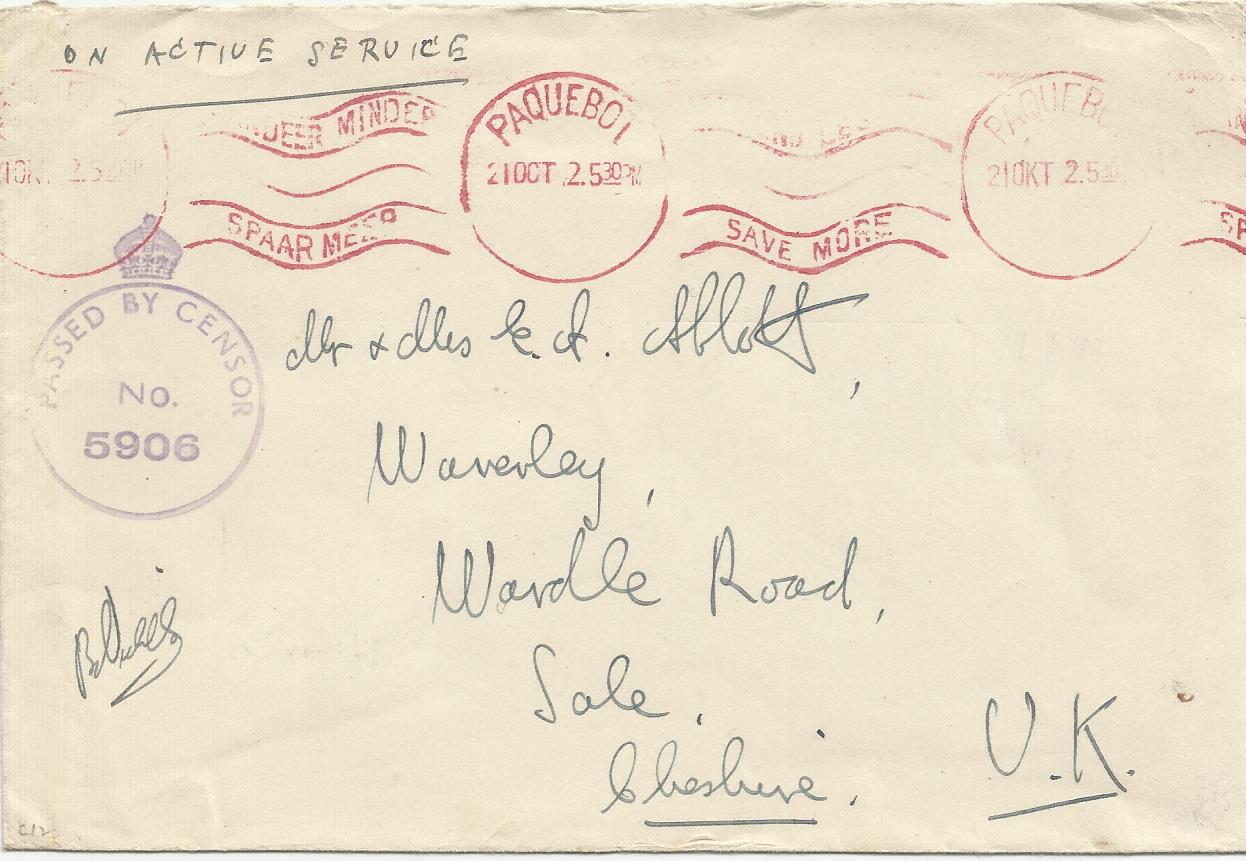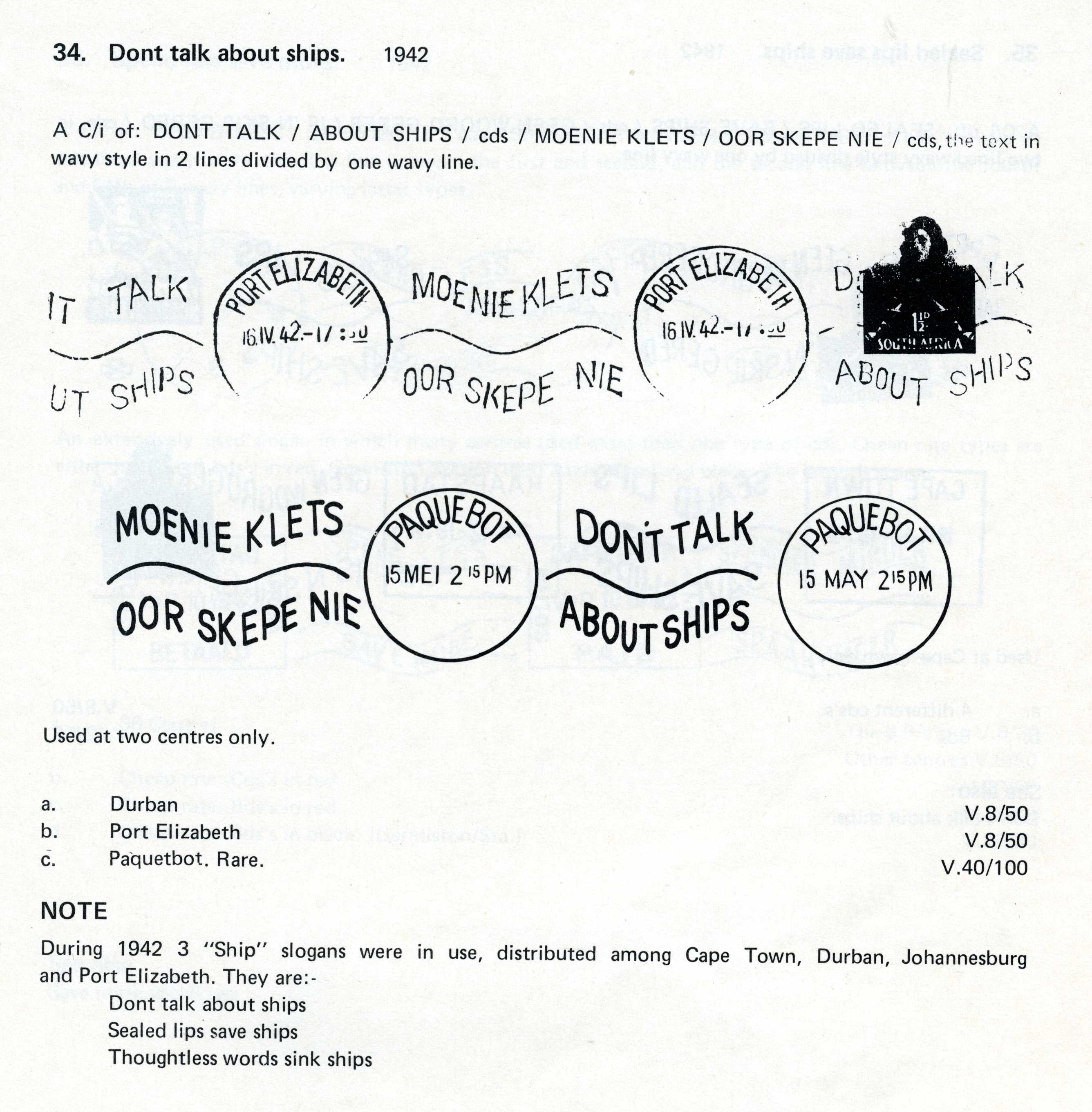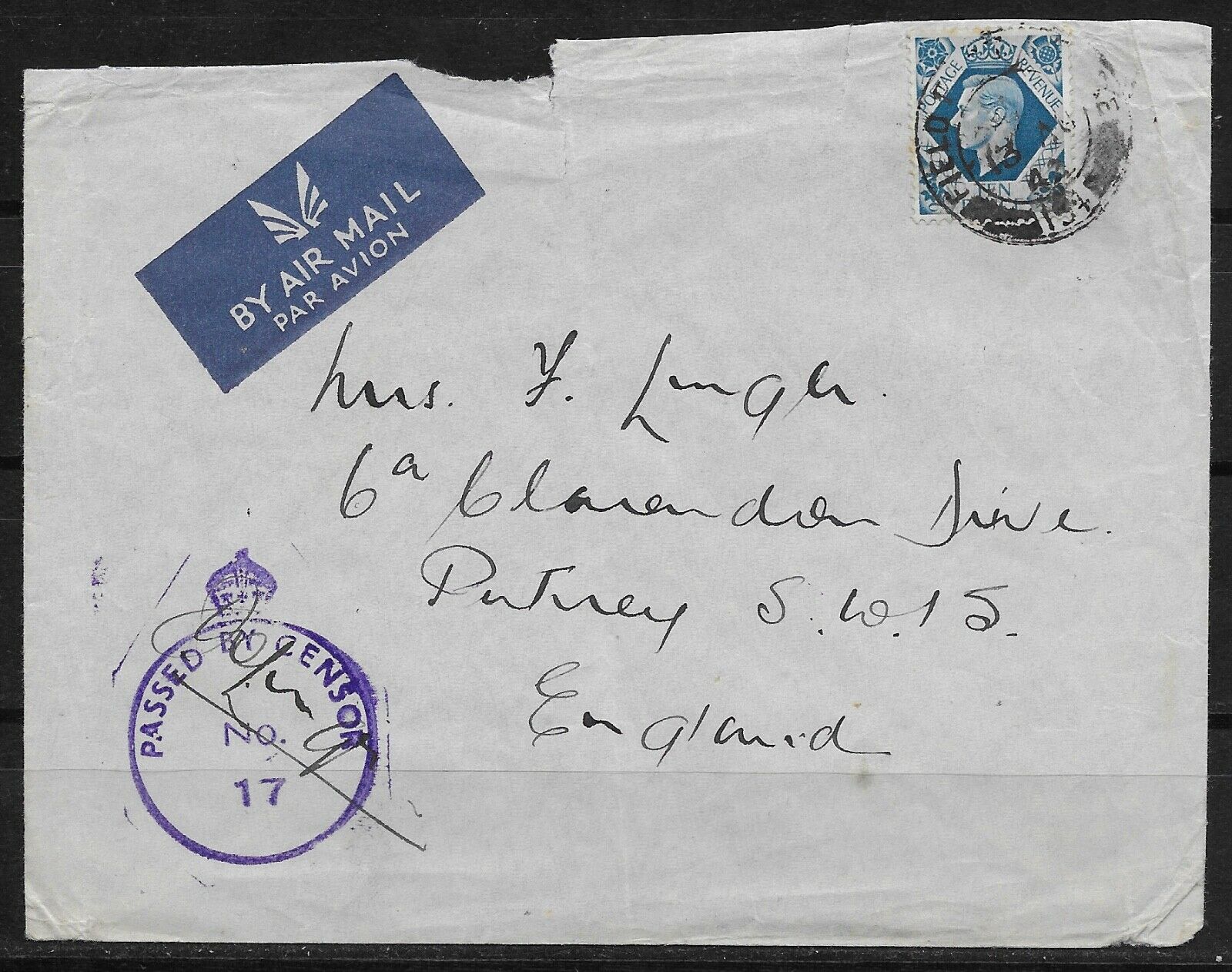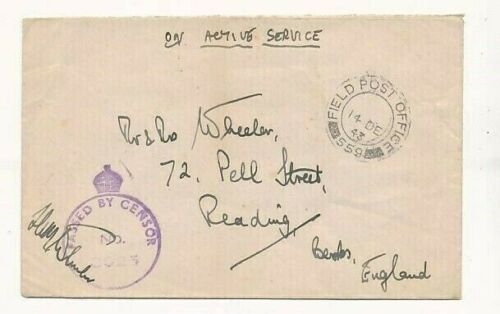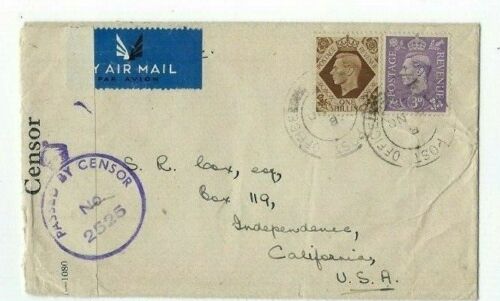Wartime patriotic and propaganda slogans.
Quote from SOLPT1 on November 27, 2020, 11:39 pmI attach a scan of a "on active service" paquebot cover dated 24 October. 1942, supposedly ex a troopship and supposedly from Cape Town. Now according to the reference book I have on South African post marks a paquebot marker with the bi-lingual "SPEND LESS/ SAVE MORE" does not exist. Have any other members seen this paquebot marker before? I have tried to find who used the censor marker as well, to no avail.
I attach a scan of a "on active service" paquebot cover dated 24 October. 1942, supposedly ex a troopship and supposedly from Cape Town. Now according to the reference book I have on South African post marks a paquebot marker with the bi-lingual "SPEND LESS/ SAVE MORE" does not exist. Have any other members seen this paquebot marker before? I have tried to find who used the censor marker as well, to no avail.
Uploaded files:Quote from Bas PAYNE on November 28, 2020, 10:45 amGreat to see this - and no reason to doubt that it's a South African machine post-mark.
The best reference on these is Vermaak SJ 1979 South African Postal Slogans.
The "SPEND LESS / SAVE MORE | SPANDEER MINDER / SPAAR MEER" slogan is one of a group of war-time slogans first used in 1942. According to Vermaak it was used at 36 post offices, but he doesn't name them. Normally it's in black; red ink was used for cheap rate stampless bulk mailings. Vermaak lists and illustrates (see scan) a PAQUEBOT cds like the one on this cover, used with another of the slogans in this group, "DON'T TALK / ABOUT SHIPS | MOENIE KLETS / OOR SKEPE NIE", dated 15 MAY (probably 1942); he also lists the use of the PAQUEBOT cds with the slogans, "SUPPORT / THE / RED CROSS | ONDERSTEUN /DIE / ROOIKRUIS".
So it's no surprise to see this one - but very nice to see it. It's probably rare; interesting that it's in red. Presumably the PAQUEBOT cds was introduced so that the postmark didn't say where the ship had come from; at about the same time Durban and Cape Town paquebot hand-cancellers had "Durban" and "Capetown" removed for the same reason.
The censorship mark isn't South African - presumably it's British, when the letter was censored on arrival.
Great to see this - and no reason to doubt that it's a South African machine post-mark.
The best reference on these is Vermaak SJ 1979 South African Postal Slogans.
The "SPEND LESS / SAVE MORE | SPANDEER MINDER / SPAAR MEER" slogan is one of a group of war-time slogans first used in 1942. According to Vermaak it was used at 36 post offices, but he doesn't name them. Normally it's in black; red ink was used for cheap rate stampless bulk mailings. Vermaak lists and illustrates (see scan) a PAQUEBOT cds like the one on this cover, used with another of the slogans in this group, "DON'T TALK / ABOUT SHIPS | MOENIE KLETS / OOR SKEPE NIE", dated 15 MAY (probably 1942); he also lists the use of the PAQUEBOT cds with the slogans, "SUPPORT / THE / RED CROSS | ONDERSTEUN /DIE / ROOIKRUIS".
So it's no surprise to see this one - but very nice to see it. It's probably rare; interesting that it's in red. Presumably the PAQUEBOT cds was introduced so that the postmark didn't say where the ship had come from; at about the same time Durban and Cape Town paquebot hand-cancellers had "Durban" and "Capetown" removed for the same reason.
The censorship mark isn't South African - presumably it's British, when the letter was censored on arrival.
Uploaded files:Quote from Steve on November 28, 2020, 12:41 pmI initially avoided PAQUEBOT marks and covers for fear of having to pronouce the word in conversation but as a collector of Simonstown material I was forced to buy covers with paquebot marks. I have now learned to say "packy-bow" which seems to be perefctly acceptable. No-one has laughed at me yet.
Curiously, I was talking to Bob Hill yesterday about a WW1 CAPE TOWN KAAPSTAD single circle machine postmark with PAQUEBOT separating the circular datestamp. He referred me to "The Maritime Marks of South Africa" written and published by RD Allen in about the late 1970s. Allen was one of the early founder members of SACS (South African Collectors' Society) in the UK. Recently I found for Bob, a SACS member, a Shipping Postmaster cover from Allen which was sent to Harvey-Pirie, the editor of the SA Philatelist. Bas, a SACS member, has recommended S J Vermaak's book to you. There is a cover to Vermaak in our Korean War Display. Recently, we ran two displays from Dr J Frank, one on 'Canadian Participation in the Boer War' and the other some reprinted articles on 'Shipping Postmaster Mail". On seeing the cover to S J Vermaak, Dr Frank wrote to me saying "the Korean War display had its moment .... a cover addressed to S. J. Vermaak. Fanie ("Brey") Vermaak was my, and David Crocker's, earliest philatelic mentor. As schoolboys in Florida (Tvl.) he taught about stamp collecting and postal history and also took us to philatelic society meetings."
Postal history goes round in interlinked circles. We do not own this material. We are its custodians. The heart of this hobby is, in my opinion, finding and sharing knowledge with like-minded collectors. Long may it continue!
Two Points:
1]. Ralph Putzel's "The Postmarks of South Africa...." does not cover machine cancellers in any detail.
2]. Before it became a key part of advertising, a slogan was a short, pithy Scots war-cry.
I initially avoided PAQUEBOT marks and covers for fear of having to pronouce the word in conversation but as a collector of Simonstown material I was forced to buy covers with paquebot marks. I have now learned to say "packy-bow" which seems to be perefctly acceptable. No-one has laughed at me yet.
Curiously, I was talking to Bob Hill yesterday about a WW1 CAPE TOWN KAAPSTAD single circle machine postmark with PAQUEBOT separating the circular datestamp. He referred me to "The Maritime Marks of South Africa" written and published by RD Allen in about the late 1970s. Allen was one of the early founder members of SACS (South African Collectors' Society) in the UK. Recently I found for Bob, a SACS member, a Shipping Postmaster cover from Allen which was sent to Harvey-Pirie, the editor of the SA Philatelist. Bas, a SACS member, has recommended S J Vermaak's book to you. There is a cover to Vermaak in our Korean War Display. Recently, we ran two displays from Dr J Frank, one on 'Canadian Participation in the Boer War' and the other some reprinted articles on 'Shipping Postmaster Mail". On seeing the cover to S J Vermaak, Dr Frank wrote to me saying "the Korean War display had its moment .... a cover addressed to S. J. Vermaak. Fanie ("Brey") Vermaak was my, and David Crocker's, earliest philatelic mentor. As schoolboys in Florida (Tvl.) he taught about stamp collecting and postal history and also took us to philatelic society meetings."
Postal history goes round in interlinked circles. We do not own this material. We are its custodians. The heart of this hobby is, in my opinion, finding and sharing knowledge with like-minded collectors. Long may it continue!
Two Points:
1]. Ralph Putzel's "The Postmarks of South Africa...." does not cover machine cancellers in any detail.
2]. Before it became a key part of advertising, a slogan was a short, pithy Scots war-cry.
Quote from Bas PAYNE on November 28, 2020, 2:04 pmThe full title of Putzel's 10-volume "The postmarks of South Africa" is very clear:
"The postmarks of South Africa. Including postmarks of former South African States and Colonies, also Basutoland, Bechuanaland and Swaziland. Including commemorative postmarks, but excluding machine postmarks." [my emphasis]
A few machine postmarks crept in in error - usually (as in the case of CAPE TOWN Put 27) when the machine was run with the cds in place but without the "flag"or canceller, most often when used as a transit or arrival date-stamp.
The full title of Putzel's 10-volume "The postmarks of South Africa" is very clear:
"The postmarks of South Africa. Including postmarks of former South African States and Colonies, also Basutoland, Bechuanaland and Swaziland. Including commemorative postmarks, but excluding machine postmarks." [my emphasis]
A few machine postmarks crept in in error - usually (as in the case of CAPE TOWN Put 27) when the machine was run with the cds in place but without the "flag"or canceller, most often when used as a transit or arrival date-stamp.
Quote from Jamie Smith on November 28, 2020, 11:16 pmInteresting that I hadn't seen a South African cover with the British 'circle with crown' PBC before and along comes another bus. This one also appears to be self censored. Could there have been a censoring problem in the Cape Town area and could that point to the paquebot cover coming from there?
Interesting that I hadn't seen a South African cover with the British 'circle with crown' PBC before and along comes another bus. This one also appears to be self censored. Could there have been a censoring problem in the Cape Town area and could that point to the paquebot cover coming from there?
Quote from SOLPT1 on December 1, 2020, 12:46 amIt is interesting that the Circular PBC with Crown censor markers are so rare in South Africa. When I first saw this cover on Ebay it had a written notation next to the censor marker on the cover which said "ex troop ship" , so it may have been from a troopship. It has been impossible to find out through philatelic sources what unit used this censor marker, but have been assured that the troopship would not have had it's own censor marker
It is interesting that the Circular PBC with Crown censor markers are so rare in South Africa. When I first saw this cover on Ebay it had a written notation next to the censor marker on the cover which said "ex troop ship" , so it may have been from a troopship. It has been impossible to find out through philatelic sources what unit used this censor marker, but have been assured that the troopship would not have had it's own censor marker
Quote from Bas PAYNE on December 1, 2020, 11:51 amScans of three covers with PBC crowned circle marks attached - two to the UK from people on active service; the third from the UK to the USA, tying an army censorship tape. It looks as if these PBC marks were probably used by British military units. My original suggestion, that the letter was censored in the UK on arrival, is probably wrong - it makes much better sense to censor at the sending end. A better suggestion seems to be that it was written and censored on a troopship; the letter was then put into the South African postal system at Cape Town or Durban, where it got the Paquebot cancellation, and then went back to the UK.
Scans of three covers with PBC crowned circle marks attached - two to the UK from people on active service; the third from the UK to the USA, tying an army censorship tape. It looks as if these PBC marks were probably used by British military units. My original suggestion, that the letter was censored in the UK on arrival, is probably wrong - it makes much better sense to censor at the sending end. A better suggestion seems to be that it was written and censored on a troopship; the letter was then put into the South African postal system at Cape Town or Durban, where it got the Paquebot cancellation, and then went back to the UK.
Uploaded files:Quote from Jamie Smith on December 1, 2020, 9:58 pmNumber 1 is North Africa or Palestine depending on whether that is a 3 or a 5 in the FPO, number 2 is West Africa and I would need a better scan to determine number 3. I don't know if the censor's numbers have ever been correlated, anyone know? If not we should give it a go!
Number 1 is North Africa or Palestine depending on whether that is a 3 or a 5 in the FPO, number 2 is West Africa and I would need a better scan to determine number 3. I don't know if the censor's numbers have ever been correlated, anyone know? If not we should give it a go!

